We’re at the start of the first stage of the Ojibwe Forests Rally with a 10.3 mile stretch of smooth, sandy, flowing road ahead of us. With about 30 seconds left before launch, my driver, Calvin Cooper, pulls on his driving gloves. We both give our safety harnesses one last tug to tighten them as I begin counting down: “Three. Two. One. Go!”
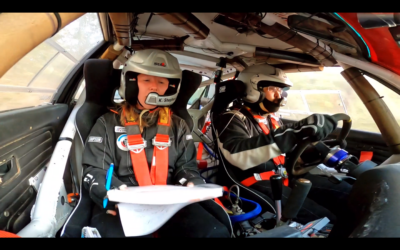
A day at the office: Team Cooper Autoworks driver Calvin Cooper and co-driver Kelsey Stephens inside their 1991 E30 stage rally car.
I hear the roar of the S52 engine and feel the rally tires hook into grit beneath us. Calvin’s eyes stay focused on the road as he launches our E30 into the lush green Minnesota forest. While he looks at the road, my eyes are glued to the notebook I am holding in front of my face; I read to him through the intercom in our helmets. The book has over 80 pages of notes, handwritten in a special shorthand, telling the story of each stage road ahead of us.
I rarely look up from my notes. Instead of seeing the road, I feel it. I time my calls with the shifting momentum of the car: “Left three into right three medium, 70 caution, Big Jump center, then left six, fifty,” I read into the microphone.

While Kelsey looks down at her notes, Calvin looks out at the Beautiful Minnesota roads.
The first time I look up from my notebook, we are nearing the jump. I press my head into the back of the seat, seeing a cheering crowd on both sides of the road and a crest so high in front of us that we can’t see what’s beyond it. Calvin presses on without slowing for the jump because I have already communicated what’s on the other side.
Calvin and I have raced together for six years, and have been a couple for eight. Our relationship, both in and out of the car, is built on trust. We fly over the crest and become airborne, and for a brief moment our 2,800-pound vehicle feels weightless. The suspension droops beneath us, only to soak up the impact of the landing when our tires meet the road again. Calvin and I don’t miss a beat as he gets right back on the throttle and I return to reading my notes. We power through the next turn.
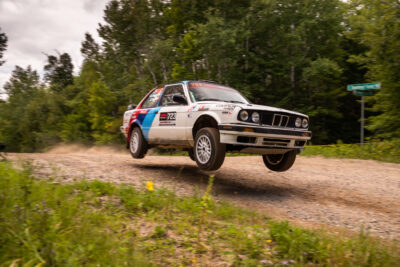
The E30 flies over the Crossroads Jump. [Photo by David Cosseboom.]
Stage rally is a point-to-point race held on public roads through National Forests and rural countryside, covering hundreds of miles both day and night. The event is broken up into smaller timed sections called stages, where the cars can race flat-out on closed roads, as well as non-competitive transit sections.
Stage times are totaled to determine the winner; it’s on these stages that we can reach speeds upwards of 100 mph across a variety of surfaces, including gravel, dirt, sand, rocks, tarmac, mud, and even snow and ice. We may also encounter massive jumps, water crossings, wildlife, and just about any other type of hazard imaginable. We need to work seamlessly together as driver and co-driver inside the car and trust each other implicitly to come out on top.
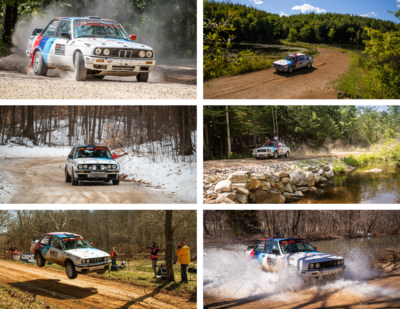
Top left: Southern Missouri Gravel by Brad Plant Photography | Top Right: Minnesota Sand by David Cosseboom | Middle Left: Michigan Ice and Snow by Ben Treffert | Middle Right: New England Rocks by David Cosseboom | Bottom Left: Missouri Cattle Guard Jump by Jake Nowack | Bottom Right: Deep Watercrossing by Ben Newburn
Since these stages cover hundreds of miles, memorization would be nearly impossible. The secret is that special notebook full of pace notes, which consist of symbols and truncated words, that I must recite to my driver at precisely the right time.
Most American Rally Association teams here in the United States follow a similar format for their own pace notes, R and L stand for Right and Left. The corners are typically graded 1 to 6 with a 6 being the fastest, and 1 being the tightest corners. Knowing the severity and direction of the corner allows the driver to point the car in the right direction at the fastest speed possible. Modifiers can provide additional information about the corner, like whether or not it is safe to cut, if the radius tightens, if it is off-camber, or if there are any other potential dangers. Double and triple-digit numbers indicate the distance to the next instruction, typically in yards or meters.
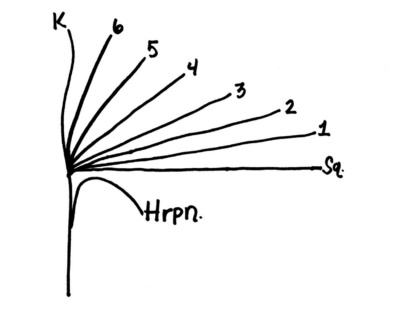
Crests, jumps, bumps, and dips are all elevation features. It’s important to note these elevation changes for a few reasons. First, they can block the line of sight to the next call. Second, these features affect the weight balance of the car, causing it to go light over crests or bumps; a dip can compress the suspension. Surface changes are important to note because grip can vary wildly from corner to corner and stage to stage. Additional features on the road could include narrow sections of road, bridges, cattle guards, gates, water crossings, sheer drops, or other natural hazards.

A page from Kelsey’s pace notebook. Note the stage length is just around seven miles, but there are ten pages of notes—over a page per stage mile!
While the co-driver reads the notes, the driver must also be able to pilot the vehicle down all kinds of surfaces while deciphering the code being given to them. Just as the driver needs to be able to trust the co-driver, the co-driver needs to be able to trust the driver’s ability to listen, decode, and handle the car. Errors from either side can have disastrous consequences.
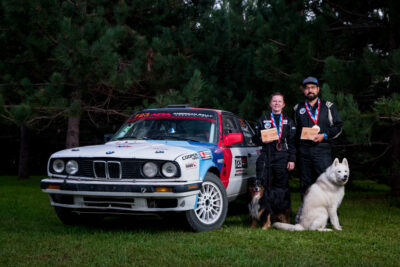
Calvin and Kelsey share the Ojibwe Forests Rally podium with their rally dogs. [Photo by R1 Images.]
The second greatest thrill is spraying your driver with champagne. Together, Calvin and I have earned podium finishes and class championships—one mile of trust and communication at a time.
Buckle up and experience our teamwork in action at the Ojibwe Forests Rally. Ebb and Flow also highlights two other BMW rally teams in our class. This is episode six of our “Flat Over Crest” series, which follows us through our 2020 season as we pursue an American Association class championship.—Kelsey Stephens
[Photos by Kelsey Stephens and as credited.]





















